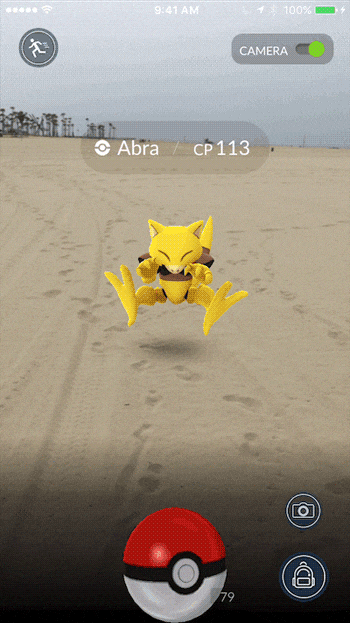Pokémon Go has taken the entire mobile-using population by storm in the last week. The game, released by Nintendo, uses augmented reality (AR) technology to place the late 90s card game, Pokémon, in a real world setting.
 Game play is pretty simple. Users download the app and then walk around their neighborhood, town, or city trying to find animated monsters that appear on a live feed supported by the phone’s camera. They then try to catch the monsters with the game’s “pokéballs.” Once any one user has acquired several characters, he can use them to engage in an augmented-reality fight with other players in real world locations. Soon users will be able to trade characters with other players. Players should also expect sponsored locations in the near future.
Game play is pretty simple. Users download the app and then walk around their neighborhood, town, or city trying to find animated monsters that appear on a live feed supported by the phone’s camera. They then try to catch the monsters with the game’s “pokéballs.” Once any one user has acquired several characters, he can use them to engage in an augmented-reality fight with other players in real world locations. Soon users will be able to trade characters with other players. Players should also expect sponsored locations in the near future.
 What is really interesting about Pokémon Go is not so much the game itself, but rather the cultural impact it has had within its short two weeks of existence. Not only has it become the most downloaded app for both iOS and Android, but it has also nearly surpassed Twitter in its number of daily users. The app has also already become the subject of humor, crime, and even controversy. And, as a result, Nintendo’s stock has skyrocketed in the past couple days, giving the company a much needed boost after nearly a decade without innovation in the gaming world.
What is really interesting about Pokémon Go is not so much the game itself, but rather the cultural impact it has had within its short two weeks of existence. Not only has it become the most downloaded app for both iOS and Android, but it has also nearly surpassed Twitter in its number of daily users. The app has also already become the subject of humor, crime, and even controversy. And, as a result, Nintendo’s stock has skyrocketed in the past couple days, giving the company a much needed boost after nearly a decade without innovation in the gaming world.
Most importantly though, Pokémon Go has brought AR into the mainstream, making it the first mainstream app in what promises to be a $90 billion industry by 2020. Even now, Nintendo has announced the app’s launch in Germany, marking the beginning of its worldwide surge.
Even though has it has only been around for a few weeks and ultimately may be a fad, Pokémon Go is a game changer for companies trying to push AR and VR. In the next few months, mobile users should expect to see a number of imitative apps trying to achieve the same success.
Embedded image via Tech Crunch.


